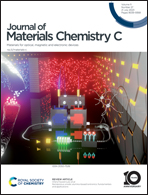Mechanochemical preparation of graphdiyne (CnH2n−2) based Ni-doped MoS2 S-scheme heterojunctions with in situ XPS characterization for efficient hydrogen production†
Abstract
Due to its distinctive sp and sp2 hybridization structure and strong electrical conductivity, graphdiyne (GDY) is commonly employed for photocatalytic hydrogen generation. However, most of the research on the preparation of GDY is restricted to organic synthesis methods. In this study, a novel mechanical ball milling method is used to prepare GDY as the electron acceptor for photocatalytic hydrogen production experiments and compounded with Ni-doped MoS2 by a hydrothermal method. NiS doping can not only serve as a template for the growth of the MoS2 flake, but also reduce the band gap of MoS2 thus reducing the energy required to stimulate photogenerated electrons to break the energy barrier, so that more photogenerated electrons migrate to the surface to participate in the photocatalytic hydrogen evolution reaction. Finally, in situ XPS showed how GDY and the doped product NM-3 formed a S-scheme heterojunction, which sped up the electron transfer and made it possible for more photogenerated electrons to participate in the hydrogen evolution reaction, further enhancing the hydrogen generation activity of NM-3.



 Please wait while we load your content...
Please wait while we load your content...